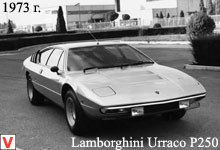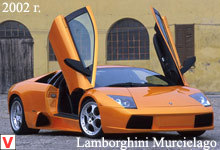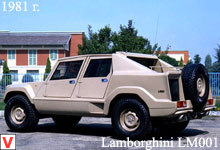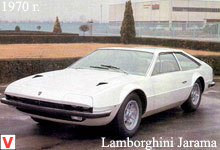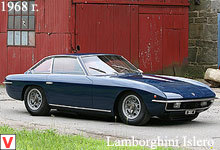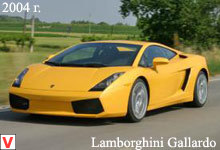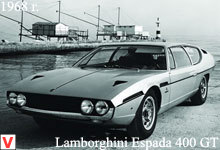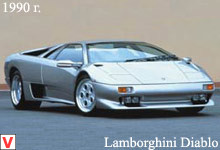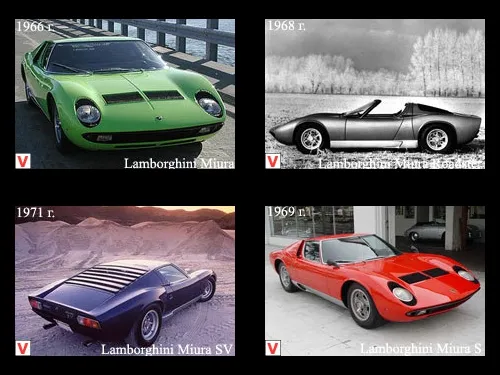
In 1965, at the Turin Motor Show, Lamborghini presented several new products, but the chassis of a mid-engine car with a transversely mounted 4-liter V-shaped 12-cylinder engine caused the greatest interest. The frame was welded, made of sheet steel and perforated in many places to facilitate the construction. This was the result of the joint work of several masters on the concept of a sports car with an engine in the base. Immediately, 10 orders were received for an undelivered car with an unknown body. Several layouts of the future car were presented, but preference was given to the variant from Bertone, which later became the Lamborghini Miura P400.
The brilliant debut of the production car was held at the Geneva Motor Show in 1966. The appearance of this model, named Miura in honor of the breed of fighting bulls, produced the effect of a bombshell in the cabin. She immediately became a sensation.
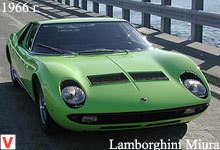
At that time, no one knew about the existence of mid-engine cars. In terms of its design and performance, Miura was many years ahead of all existing cars. The main blow fell on the Ferrari, which at that time did not have a production car with a V12 in the database. The full official model name was Miura P400, (P — meaning rear engine, 4 — engine size). It was with Miura that the Lamborghini march began across the world as an elite car manufacturer. This is the first model that won the proud title of "supercar". For that time, Miura was a unique machine. One of its kind was breathtaking.
The idea of design belongs to Marcello Gandini, who worked at Bertone at that time. The car is a squat - its height is only 1055 mm. To get into the car, you need to press the lock button, which is hidden in the ventilation slots located in the upper part of the door.
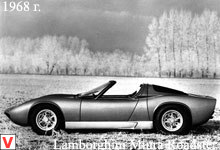
The exterior of the Miura was distinguished by expressive headlights framed by black contrasting “eyelashes”. The model was equipped with a four-liter alloy 12-cylinder engine located behind the driver across the car on a special frame. The creator of the engine is Giotto Bizarini. He was the oldest of the entire Miura development team. A model weighing 980 kg accelerated to "hundreds" in 5.7 s, and the maximum speed reached 273 km / h. The presence of sharp steering and disc brakes gave a sense of confidence behind the wheel.
A year after the debut of the coupe in Brussels showed Miura Roadster. Italians have worked hard on the aerodynamics of this open version - due to some changes in the body, the maximum speed exceeded 300 km / h. Miura Roadster is also known as Spider or Spyder, but these names were not official.
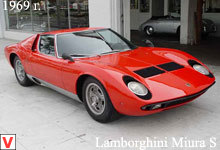
Subsequently, the car was updated, resulting in the appearance of the Lamborghini Miura with the Zn75 index. It was shown at all significant automobile exhibitions, and then sold at auction. In the early 80s she was in the Boston Museum of Transport.
In a word, the matter did not go further than the prototype. In 1969, the Lamborghini Miura was modernized. The car received an index S (Spinto) in the title and an additional 20 l.c. to engine power.
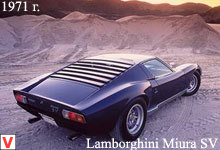
Updates included reworking the suspension, a complete set of new Pirelli Cinturato tires, as well as ventilated brake discs and automatic windows. However, the most serious difference from the first models was the use of heavy calibrated steel for the body. According to records stored in the archives of the company, the thickness of the metal on the first 125 machines was 0.9 mm, and on all subsequent machines - 1 mm. Innovations have touched and interior. The glove box got a lock, and the wooden steering wheel was replaced with leather-covered. Modified and the central dashboard.
Externally, the Miura S practically did not differ from its progenitor. Having released only 140 cars of the Miura S version, at the Geneva Salon of 1971, Lamborghini introduced her deputy Miura SV (Sport Veloce). Under the hood is an advanced 12-cylinder V-engine with a volume of 3929 cm3 with larger diameter valves and modernized carburetors.
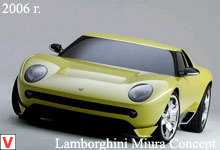
Engine power increased by 15 horsepower compared to the previous model and reached 385 hp. at 7850 rpm. The increase in power led to an increase in fuel consumption, so the optional installation of a fuel tank of increased capacity (110 liters) was proposed. The gearbox now had its own engine-independent lubrication system, which made it possible to use special types of oil in the transmission. Externally, the Miura SV differed from its predecessors by the absence of "eyelashes" around the headlights and wider wings, fitted with new 9-inch wheels with Pirelli Cinturato tires. The speed of the car reached 288 kilometers per hour, and the acceleration time to 100 km / h was 5.5 seconds.
In total, Lamborghini produced 150 Miura SV units, including those owned by Frank Sinatra. This modification was the fastest Lamborghini of the time, but its release, like all Miura, was discontinued in 1972, in order to release the forces and means to fine-tune the successor to the Countach model. Within six years, about 800 units were sold, which is a very high figure for machines of this class. Miura has been bought by many celebrities and young rich hangers. The car is still considered one of the best ever created by Lamborghini. When Miura was removed from production, everyone was talking about the revival of the model, but the question was when.
And 40 years later, the long-awaited premiere of the conceptual prototype of the new superkupe, named Lamborghini Miura, took place. The car was created by the designer Walter De'Silva. The project embodies the motives of a retro car, wrapped in modern features of the brand. Despite the fact that the concept car is like a modern version of the first Lamborghini Miura, its appearance is in many ways reminiscent of the progenitor. Here are the same smooth body lines, round headlights and characteristic air intakes behind the side doors as on the old model. The rear mounted spoiler automatically changes the angle of inclination depending on the speed, ensuring high stability at any speed.
Under the hood of the concept presented in Detroit, there was a 6.2 liter engine installed on the Murcielago, with an increased volume of up to 6.5 liters and an output of 700 hp. The twin turbocharger and seven-speed DSG gearbox with sequential gear shifting are borrowed from the Bugatti Veyron 16.4. It is expected that the serial Miura will get four-wheel drive, ceramic disc brakes, magnesium alloy wheels and carbon body panels.
